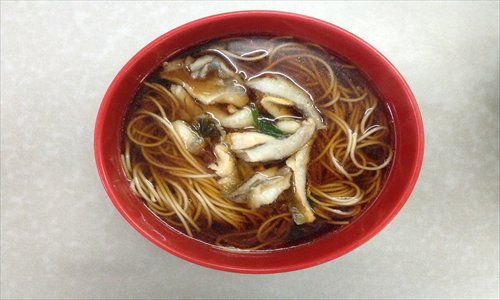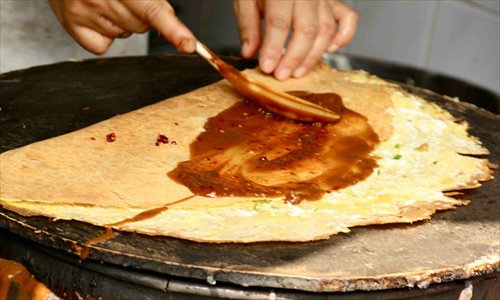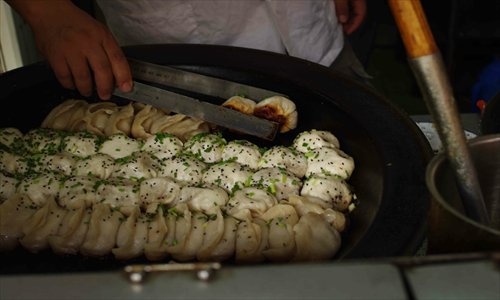The good taste tour guides

Food tourism, the pursuit of unique and memorable eating and drinking experiences, is still largely a niche market in Shanghai's tourism industry. But trailblazers Jamie Barys and Kyle Long are changing that. They have been running food tours in the city under their UnTour Shanghai label for more than two years.
"In China, the typical tour group experience often involves giant groups wearing matching neon hats and T-shirts following megaphone-toting guides to overrun tourist spots that you can find in all the guidebooks. After seeing these typical 'follow the flag' tours, we knew we wanted to be different and create genuine experiences that showcased a part of the city most tourists don't have access to.
"Thus, the 'UnTour' is the opposite of a typical tour - very small groups where guests get to know the guide personally and really feel immersed in the local culture," Barys and Long told the Global Times in a recent talk about Shanghai's street food culture at M on the Bund.
UnTour Shanghai offers weekly group tours as well as several options for private tours navigating the city's dining scene and revealing the hidden gems at food stalls and alleyway eateries. The group tours include street breakfast eats and night markets, noodles and dumplings and last between three and four hours. They limit the numbers to keep the tours intimate and personal.
Intimidating
"We know how intimidating it can be, traveling to a new city and trying to partake of local foods without speaking the language. To avoid this and help tourists get off on the right foot, we provide all of our customers with a welcome package that includes restaurant and menu recommendations in the neighborhood. After the tour, we offer more information for the guests to fully utilize their time in Shanghai and help them plan their meals," explained Long, an Oregon native who has been living in Shanghai for five years.
Barys agreed. "Eating at local, authentic Chinese restaurants can be a very daunting experience, especially for visitors who are unfamiliar with the city and don't speak the language. Plus Chinese menus are notoriously long, so even if tourists or expats do end up at a great restaurant, they can still have a mediocre meal, depending on what they order. When we first started UnTour Shanghai, Kyle and I wanted to take the guesswork out of finding the best places to eat in Shanghai to make sure every bite for our guests was memorable." Tennessee native Barys has lived in Shanghai for more than six years.
Long said that since Shanghai is an increasingly important center for international business, they now have many expat clients who have been posted for a year or more to the city and wanted to know about the local food culture, what was safe to eat, and how to order in restaurants. "We also try to help enrich their time in Shanghai by opening the door to eating like the locals."
Barys and Long studied together in Beijing during their junior year of college. They found different paths back to Shanghai to link up again after graduation. Long moved to Shanghai to teach English while Barys did an immersive language program in Hangzhou and then worked in public relations and marketing in Shanghai.
Sharing their love for food and a firm belief that culinary tourism is on the rise in the world as more and more travelers look for authentic dining experiences, Barys and Long established their own culinary tour company. They had by then spent a combined decade eating their way through Shanghai.
"When we first started, most people advised 'never do business with a friend.' But we've come to realize that since we know each other well, we have very open communication lines and thus a high level of trust in each other. We can usually anticipate what the other is thinking which has helped us continue to allocate separate duties and tasks," Long said.

Rewarding experience
Barys said that another rewarding experience they have as food tour guides in Shanghai is "when guests tell us that they felt empowered to try out little hole-in-the-wall shops after our tour, and discovered delicious dishes on their own."
Finding and promoting good street food can be a major undertaking. The pair often resort to dianping.com, a popular Chinese consumer website. "We not only use this to search for specific dishes, but also rely on a network of friends, former colleagues, taxi drivers and other locals who love food as much as we do and want to share their favorite secret spots," Barys explained.
"I was a food tour guide one day and a convenience store clerk tipped me off about one of our now favorite noodle shops. The more people you talk to, the more you'll discover," Long said.
Another challenge is helping their clients remain untroubled by food safety fears while they dine on the streets. The pair wrote an in-depth article on culinarybackstreets.com, a popular international online guide to local eats. "As curious eaters, we often find ourselves snacking on about anything we come across in Shanghai, but there are some commonsense guidelines we make sure we follow to stay safe."
So whenever they're enjoying city street foods they check for reused oil, are wary of roving food carts, consider the time of cooking and avoid processed foods. They also suggest tourists use their own commonsense and their eyes and noses when selecting food, and they should not rely totally on food safety ratings or avoid poultry completely.
They believe food safety in China is improving after the Chinese government implemented harsh penalties on failing food regulators and business leaders.

Cult following
The Global Times joined UnTour's "Oodles of Noodles" culinary walk on a Monday afternoon. Starting at Fuxing Park at the heart of the city's former French concession, the tour guide Carla led a small group to explore Shanghai's culinary noodle underworld which has developed a cult following.
The first stop was the Wei Xiang Zhai on Yandang Road. The decades-old eatery boasts a great variety of noodles. The group tried the shop's signature dish, majiang mian (sesame peanut noodles), served hot and dry with thick, creamy peanut sauce and sesame paste on top. The homemade egg noodles were rich and chewy.
Then followed another five noodle styles at tucked-away eateries - congyou banmian (noodles with scallion oil and soy sauce) at Ding Te Le on Huaihai Road Middle, yellow croaker noodles and hairy crabmeat paste noodles at A Niang Noodles on Sinan Road, and hand-pulled noodles with beef and sliced noodles with fried beef at Lanzhou Lamian on Nanchang Road.
Anna Lee is a Thai-Chinese noodle fan who joined the Monday walk. "I really enjoyed the tour, and our guide was very knowledgeable about Shanghai, the former French concession area and the food itself. As a tourist it is difficult to know what to order and where to go. Our guide was very easygoing, friendly and helpful - she explained all the different dishes that we ate and I learnt a lot. So if you love food, it's a great way to see part of the city, and to experience eating what the locals eat and where they eat."
Also enjoying the noodle tour was Briton Anya Chambers, who has been in Shanghai for two years. "I've known about UnTour for some time but I decided to join this week as I am about to leave Shanghai. The amazing food has been so much a part of my time here and I've tried a lot of it. Noodles are my absolute favorite however, and I wanted to make sure that I had covered all the different types of noodles before leaving.
"The tour was great - I wanted to try some different noodles and I definitely did that. Part of the fun is eating in some small, hole-in-the-wall restaurants that you might not otherwise notice. Sampling many different local foods wherever I travel is my favorite way of finding out about a place. I love so many of the dumplings and so many other delicious treats you find in Shanghai, but I have never met a noodle I didn't like!"
Some of Jamie Barys and Kyle Long's favorite Shanghai street foods include shengjianbao (pan-fried buns stuffed with pork) at Da Hu Chun, one of the city's oldest fried pork bun shops, which first opened in the 1930s. "The fried buns at Da Hu Chun are juicy, have a lot of sesame flavor, and are shaped differently than the ones you find at better-known restaurants."
Another choice is congyoubing (scallion oil pancakes) at A Da's on Maoming Road South. Although scallion oil pancakes are a common breakfast dish in Shanghai, the street food vendor surnamed Wu at A Da's turns these little savory rounds stuffed with salty pork and scallions into works of art. "We love Mr Wu's scallion pancakes because he goes the extra step and places the fried pancakes on his griddle flame to crisp the outside.
"We also love eating jianbing (Chinese crepes) just about anywhere in the city we can find them. The mixture of spicy, salty, and sweet all wrapped up together makes them the perfect breakfast food to go," said Long.
Two favorite late-night snacks are youtiao (deep-fried dough sticks) and doujiang (soybean milk) at the Lao Shaoxing Doujiang Shop on Zhaozhou Road, Huangpu district.

Special atmosphere
"The atmosphere at this late-night-only stall is really special. You have to come between 10 pm and 6 am to get their doujiang, and there's almost always a line. So make sure to grab a container and take some home after you've eaten a bowl on the street!" Barys advised.
After spending years exploring Shanghai's food stalls and small eateries tucked away in backstreets and lanes, the pair are disappointed at seeing many local food spots disappear as Shanghai develops.
"Unfortunately as buildings get renovated and neighborhoods get gentrified, street food is usually seen by developers as an undesirable element. In reality, it is the local food and hometown specialties that you find in pushcarts and back alleys around Shanghai that really make the city unique. This is the side of the city that most visitors want to see - another mall with the same luxury brands you can find in Singapore, Hong Kong or every other major city doesn't make for a very interesting travel experience.
"We hope that as the city develops, there will be some balance between modernity and luxury and preserving the culinary heritage and traditional street scenes," these two culinary-savvy, street-smart guides commented.